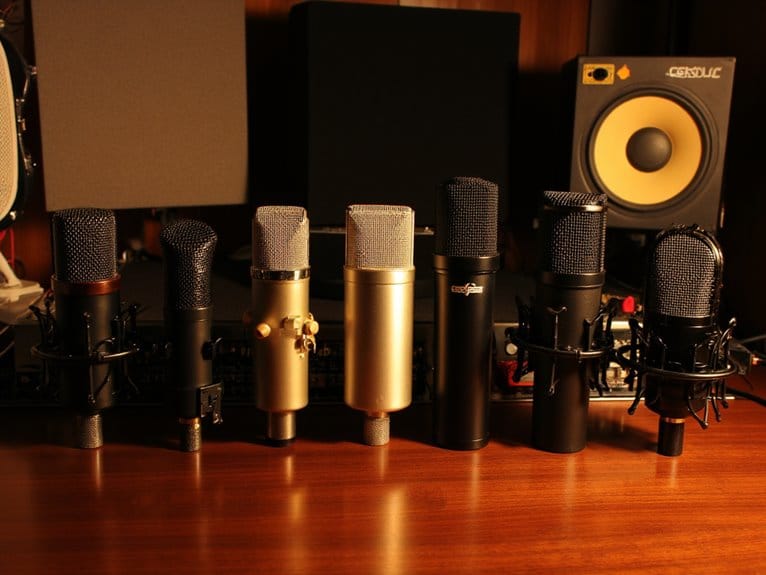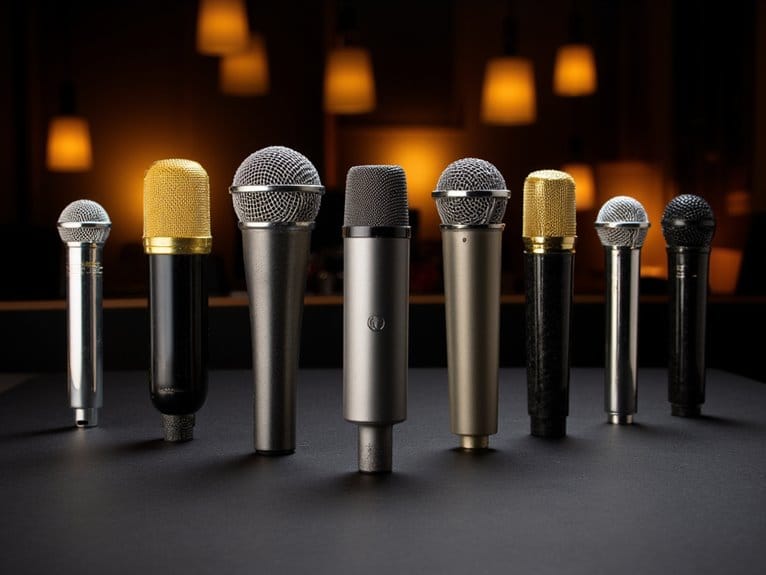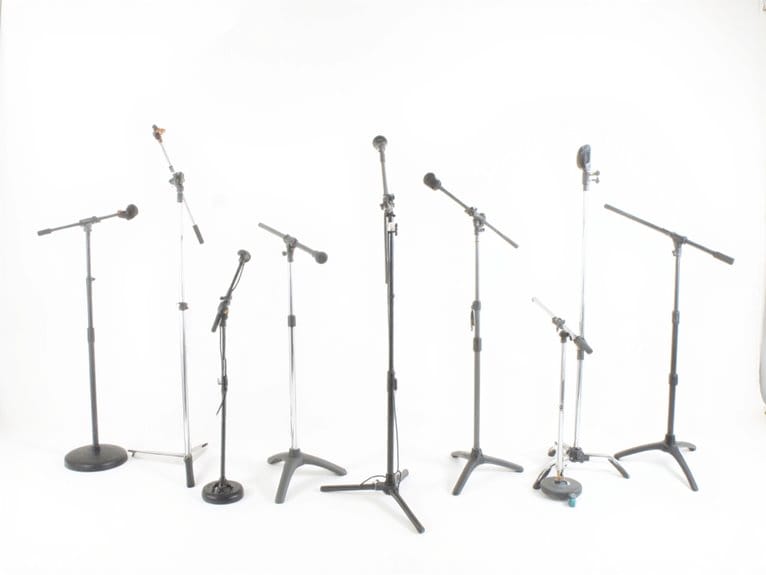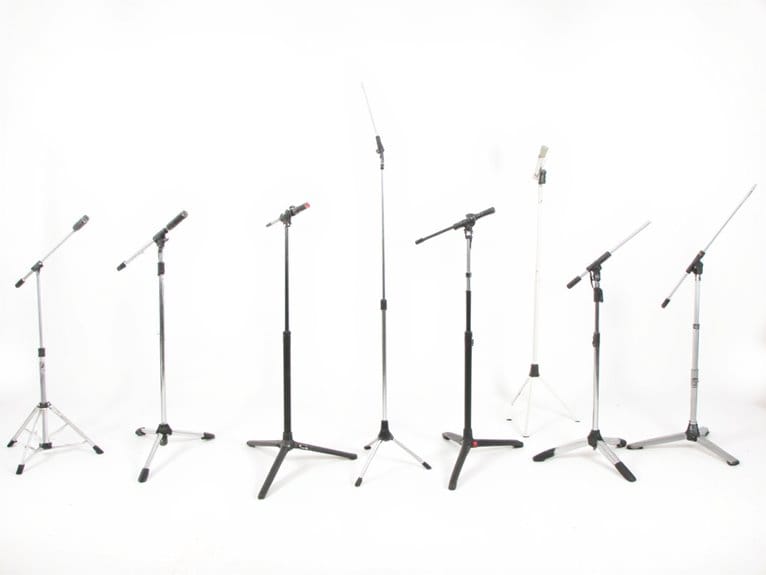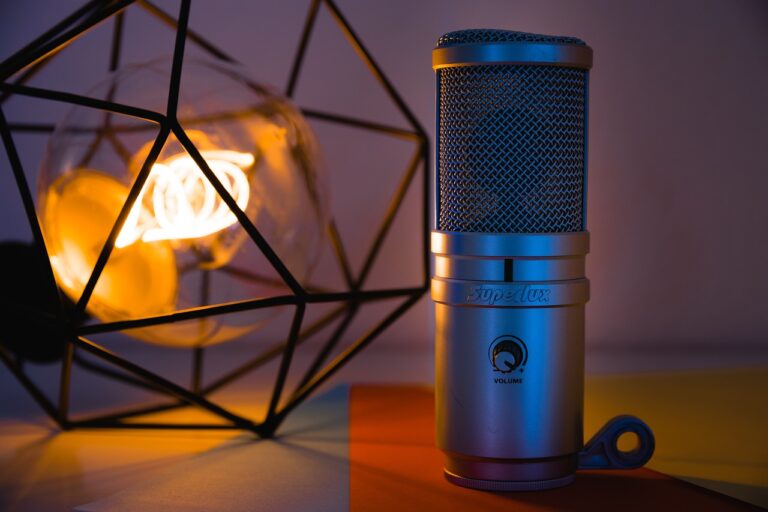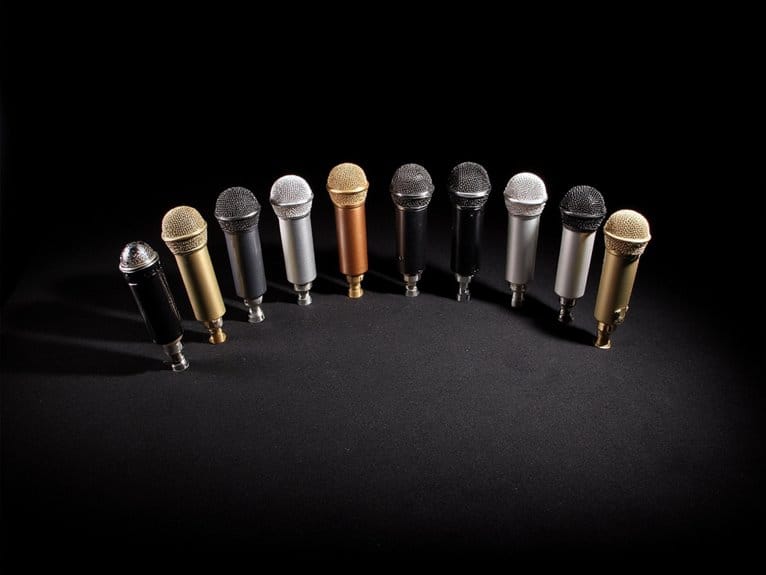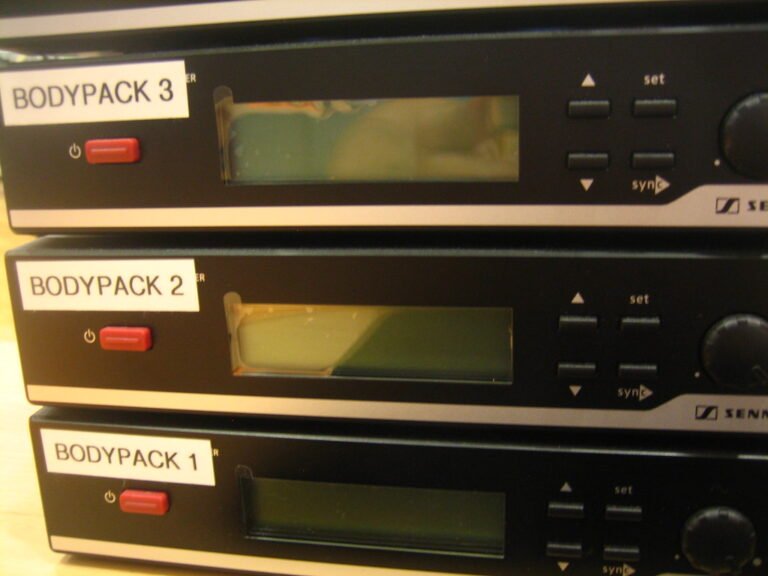10 Best Home Recording Microphones for Professional-Quality Audio
After extensive testing, I’ve found that professional home recording hinges on choosing the right microphone type for your specific needs. Dynamic mics like the TONOR TC-777 excel in noisy environments, while condenser models such as the FIFINE T669 and MAONO AU-A04 deliver studio-quality vocals with their cardioid capsules and 192kHz/24-bit sampling rates. USB connectivity offers plug-and-play convenience, though XLR options provide greater flexibility. The complete story involves understanding frequency response, signal-to-noise ratios, and essential accessories that separate amateur recordings from professional results.
We are supported by our audience. When you purchase through links on our site, we may earn an affiliate commission, at no extra cost for you. Learn more.
Notable Insights
- Condenser microphones excel in home studios, capturing detailed vocals and instrument subtleties with professional-quality audio reproduction.
- Dynamic microphones offer superior durability and noise rejection, making them ideal for untreated home recording environments.
- USB/XLR dual-connectivity microphones provide maximum flexibility for both beginner setups and professional audio interface integration.
- Essential specifications include 20Hz-20kHz frequency response, 70+ dB signal-to-noise ratio, and 192kHz/24-bit sampling rates.
- Complete accessory kits with boom arms, shock mounts, pop filters, and adapters ensure immediate professional recording capability.
TONOR TC-777 Podcast Microphone, USB Computer Mic with Tripod Stand and Pop Filter

The TONOR TC-777 stands out as an exceptional choice for content creators who need professional-quality audio without breaking the bank, combining essential recording accessories with plug-and-play simplicity that eliminates the technical barriers I’ve seen frustrate many beginners. You’ll appreciate the cardioid pickup pattern that captures your voice clearly while suppressing distracting background noise, making it perfect for podcasting, streaming, gaming, and online conferences. The USB 2.0 connectivity works seamlessly with Windows, Mac, PS4, and PS5 systems, though Xbox users will need to look elsewhere. The complete package includes everything you need: a foldable tripod stand, shock mount, pop filter, foam windscreen, and 1.5-meter power cord, eliminating additional purchases.
Best For: Content creators, podcasters, streamers, and gamers who need professional-quality audio recording with plug-and-play simplicity and don’t want to invest in expensive equipment or deal with complex setup procedures.
Pros:
- Complete all-in-one package includes tripod stand, shock mount, pop filter, and windscreen, eliminating the need for additional purchases
- Plug-and-play USB 2.0 connectivity works seamlessly across multiple platforms including Windows, Mac, PS4, and PS5 without requiring drivers
- Cardioid pickup pattern effectively captures clear voice audio while suppressing background noise for professional-sounding recordings
Cons:
- Not compatible with Xbox gaming systems, limiting its versatility for console gamers
- USB connection means it’s dependent on computer power and may have limitations compared to XLR microphones for advanced users
- Tripod stand design may take up desk space and could be less stable than a dedicated boom arm setup
Sound Town 4 Channel UHF Wireless Microphone System with 4 Handheld Mics

Multi-microphone setups become essential when you’re recording group discussions, family podcasts, or small musical ensembles at home, and Sound Town’s 4 Channel UHF Wireless Microphone System delivers exactly that capability with its quartet of handheld mics and professional rack-mountable receiver. You’ll appreciate the UHF frequency range (510-560 MHz) that reduces interference, while the 200-foot operating range provides ample freedom of movement during recordings. The system offers both 1/4″ and XLR outputs for versatile connectivity, though some users report occasional signal dropouts every five minutes during extended sessions. At 4.2 stars from 474 reviews, it’s proven reliable for home streaming and small gatherings.
Best For: Content creators, podcasters, and small event organizers who need a reliable multi-microphone wireless setup for group recordings, family podcasts, church services, or intimate musical performances.
Pros:
- UHF frequency range (510-560 MHz) reduces interference compared to VHF systems and provides stable signal transmission up to 200 feet
- Versatile connectivity options with both 1/4″ and XLR outputs, plus rack-mountable receiver with independent volume controls for each channel
- Durable construction with metal housing, steel mesh grilles, and built-in pop filters that enhance sound quality and withstand regular use
Cons:
- Some users experience signal dropouts every 5 minutes during extended recording sessions, which can disrupt longer content creation
- On/off buttons feel low quality and may not hold up well under heavy professional use or frequent operation
- Limited to 4 fixed frequencies rather than selectable channels, which may cause issues in crowded RF environments
Wireless Microphones with One-to-One Chip Connection, 40H Duration

For content creators and home recording enthusiasts seeking wireless freedom without sacrificing reliability, the ECHOMUSSY G58S wireless microphone system delivers an impressive combination of innovative chip technology and marathon battery performance. The system’s dual smart chips create a one-to-one connection that eliminates the pairing headaches I’ve experienced with cheaper wireless mics, while the automatic connection system means you’ll spend less time troubleshooting and more time recording. With its remarkable 40-hour battery life and 200-foot range, this lightweight system supports both 6.35mm and 3.5mm interfaces, though you’ll need to look elsewhere if you’re hoping for USB-C compatibility-a minor limitation in an otherwise solid package.
Best For: Content creators, home recording enthusiasts, and anyone seeking reliable wireless microphone performance for singing, speaking, or video recording with extended battery life.
Pros:
- Exceptional 40-hour battery life with 200-foot wireless range for extended use
- Dual smart chip technology with one-to-one connection eliminates pairing issues and provides stable signal reception
- Plug-and-play functionality with automatic pairing system requires no drivers or complex setup
Cons:
- Limited to 6.35mm and 3.5mm interfaces only, lacking modern USB-C compatibility
- Instruction manual clarity could be improved according to user feedback
- Positioned for casual to semi-professional use rather than full professional applications
Logitech Blue Yeti USB Microphone for Gaming, Streaming & Podcast

When you’re serious about creating professional-quality content for streaming, podcasting, or gaming, the Logitech Blue Yeti USB Microphone stands out as a versatile powerhouse that delivers broadcast-quality sound through its custom three-capsule array design. You’ll appreciate its four pickup patterns-cardioid, omni, bidirectional, and stereo-which adapt to virtually any recording scenario you encounter. The onboard controls let you adjust headphone volume, pattern selection, instant mute, and mic gain without software dependency, though I’ve found the Blue VOICE software adds valuable vocal enhancements. With its 20 Hz to 20 KHz frequency response and 70 dB signal-to-noise ratio, this 3.2-pound microphone consistently earns praise from 8,563 customers who rate it 4.6 stars.
Best For: Content creators, streamers, podcasters, and gamers who need professional-quality audio recording with versatile pickup patterns and plug-and-play simplicity.
Pros:
- Four pickup patterns (cardioid, omni, bidirectional, stereo) provide exceptional versatility for different recording scenarios
- Broadcast-quality sound with custom three-capsule array and wide 20 Hz to 20 KHz frequency response
- Convenient onboard controls for headphone volume, pattern selection, instant mute, and mic gain without software dependency
Cons:
- Default always-on state with blinking mute indicator can be distracting during use
- Sensitive Mini USB port may be prone to connection issues over time
- Large and heavy design at 3.2 pounds takes up significant desktop space
FIFINE Studio Condenser USB Microphone Kit with Adjustable Boom Arm (T669)

The FIFINE Studio Condenser USB Microphone Kit (T669) emerges as a compelling entry-level solution for content creators who need professional-quality audio without breaking the bank, delivering crystal-clear recordings through its cardioid condenser capsule and inclusive accessory package. You’ll appreciate the inclusive kit’s all-steel scissor boom arm, shock mount, and double pop filter, which provide everything needed for immediate podcast or streaming setup. The 20Hz-20KHz frequency response captures vocals with remarkable warmth, while the 78 dB signal-to-noise ratio minimizes unwanted background interference during recording sessions. Though you’ll encounter occasional stability issues with the boom arm positioning, the T669’s plug-and-play USB connectivity works seamlessly with popular software.
Best For: Entry-level content creators, podcasters, streamers, and YouTubers who need professional-quality audio recording with a complete accessory kit at an affordable price point.
Pros:
- Crystal-clear audio quality with cardioid condenser capsule and wide 20Hz-20KHz frequency response that captures warm, professional-sounding vocals
- Complete all-in-one kit includes steel scissor boom arm, shock mount, double pop filter, and 8.2ft USB cable for immediate setup
- Plug-and-play USB connectivity with no drivers required, compatible with popular recording software like OBS and Audacity
Cons:
- Not compatible with gaming consoles like Xbox or mobile phones, limiting versatility for some users
- Boom arm can have stability issues with positioning and may require frequent readjustment during use
- Occasionally picks up background noise and some users find the pop filter adjustments challenging to manage
FIFINE USB/XLR Dynamic Microphone for Podcast Recording (AmpliGame AM8)

Content creators who demand professional versatility without breaking the bank will find the FIFINE USB/XLR Dynamic Microphone (AmpliGame AM8) strikes an impressive balance between functionality and affordability. This dual-connectivity powerhouse delivers cardioid pickup patterns with 50Hz-16KHz frequency response, effectively rejecting background noise while maintaining vocal clarity through its dynamic capsule design. You’ll appreciate the plug-and-play USB functionality alongside XLR compatibility, which means seamless shifts between casual streaming sessions and professional studio setups without purchasing additional equipment. The built-in headphone monitoring, tap-to-mute LED functionality, and customizable RGB lighting create an engaging user experience, while the 4.5-star rating from over 5,700 customers validates its reliability for podcasting applications.
Best For: Content creators, podcasters, and streamers who need versatile dual-connectivity options (USB/XLR) with professional audio quality at an affordable price point.
Pros:
- Dual USB/XLR connectivity allows seamless transition between casual and professional setups without additional equipment
- Cardioid dynamic design effectively rejects background noise while maintaining vocal clarity, ideal for untreated recording environments
- Built-in monitoring, tap-to-mute LED functionality, and customizable RGB lighting enhance user experience during live streaming and recording
Cons:
- Some users reported low volume issues that may require software adjustments and proper setup optimization
- Limited frequency response range (50Hz-16KHz) compared to higher-end professional microphones
- Constructed partially of ABS plastic which may feel less premium compared to all-metal alternatives
Upgraded Studio Recording Microphone with Isolation Shield & Pop Filter for Podcasting

Budget-conscious podcasters and aspiring content creators will find exceptional value in this thorough studio recording microphone kit, which combines professional-grade audio capabilities with beginner-friendly operation through its plug-and-play USB connectivity. You’ll appreciate the cardioid polar pattern technology with its 16mm diaphragm, delivering 192kHz/24Bit sampling rates across a 30Hz to 16kHz frequency range for crystal-clear recordings. The foldable isolation shield features five high-density sound-absorbing panels that effectively minimize background noise, while the extensive kit includes everything you need: pop filter, tripod stand, headphones, and multiple adapters for seamless smartphone integration.
Best For: Budget-conscious podcasters, aspiring content creators, and beginners who want a complete studio recording setup with professional-grade audio quality and plug-and-play simplicity.
Pros:
- Complete all-in-one kit with professional features including cardioid polar pattern, 192kHz/24Bit sampling rate, and effective noise isolation shield
- Plug-and-play USB connectivity works seamlessly with PC, smartphone, and laptop without requiring additional hardware
- Excellent value package includes all necessary accessories (pop filter, tripod, headphones, adapters) at an affordable price point
Cons:
- Some users report occasional static issues during recording sessions
- Components can be difficult to adjust and position properly for optimal setup
- Build quality may not match higher-end studio microphones for professional broadcasting applications
MAONO Vocal Condenser Cardioid Podcast Microphone with Studio Headphone Set (AU-A04H)

MAONO’s AU-A04H bundle emerges as a compelling choice for content creators who need both recording and monitoring capabilities in one all-encompassing package, combining a professional-grade condenser microphone with studio headphones that work seamlessly together. You’ll appreciate the microphone’s 192kHz/24bit sampling rate, which delivers exceptional clarity through its 16mm electret condenser transducer, while the included studio headphones feature 50mm drivers with active noise reduction technology. The complete setup includes everything you need: adjustable scissor arm stand, shock mount, pop filter, and various adapters for versatile connectivity across different devices and platforms.
Best For: Content creators, podcasters, and streamers who want a complete recording setup with professional-quality audio capture and studio-grade monitoring capabilities in one comprehensive bundle.
Pros:
- Complete all-in-one solution with professional microphone, studio headphones, and all necessary accessories included
- High-quality audio with 192kHz/24bit sampling rate and anti-interference features for crystal-clear recordings
- Versatile compatibility across multiple devices and platforms with included adapters and connectivity options
Cons:
- Frequency response limited to 16kHz may not capture the full audio spectrum for audiophile-level applications
- USB-powered setup may lack the power and flexibility of XLR microphones with phantom power
- Bundle approach means you can’t upgrade individual components without replacing the entire system
FIFINE USB Microphone for Recording and Streaming (K669B)

When you’re seeking a reliable workhorse that bridges the gap between amateur enthusiasm and professional aspirations, the FIFINE USB Microphone K669B emerges as a compelling choice for streamers, podcasters, and content creators who demand plug-and-play simplicity without sacrificing audio quality. This metal-constructed condenser microphone delivers clear, smooth audio capture while minimizing background noise through its cardioid pickup pattern, making it particularly effective for gaming sessions, voice-overs, and livestreaming applications. You’ll appreciate the straightforward USB-A connectivity with its generous 5.9-foot cable, though Mac users with newer USB-C models will need an adapter. The built-in volume knob provides real-time sensitivity adjustments, ensuring ideal input levels across Discord, OBS, and Zoom.
Best For: Content creators, streamers, and podcasters who want professional-quality audio recording with simple plug-and-play setup for PC, Mac, and PlayStation gaming.
Pros:
- Plug-and-play USB connectivity with no phantom power required, making setup quick and straightforward
- Durable metal construction with stable tripod stand ensures reliable performance and longevity
- Built-in volume knob allows real-time sensitivity adjustments for optimal audio levels
Cons:
- Not compatible with Xbox gaming consoles or mobile phones, limiting versatility
- Requires separate adapter for newer MacBooks with only USB-C ports (adapter not included)
- May require manual adjustment of automatic volume settings in some applications like Zoom
MAONO USB Microphone 192KHZ/24Bit PC Condenser Mic Kit (AU-A04)

The MAONO AU-A04 stands out as an exceptional choice for content creators who need professional-grade audio without the complexity of traditional studio setups, thanks to its true plug-and-play USB connectivity that eliminates the need for additional drivers or sound cards. What impressed me most about this microphone is its 192kHz/24-bit sampling rate paired with a 16mm electret condenser transducer, which delivers remarkably crisp vocals and strong bass response across its 30Hz-16kHz frequency range. You’ll appreciate the thorough kit that includes a sturdy scissor boom arm, shock mount, pop filter, and foam windscreen-essentially everything you need to start recording immediately.
Best For: Content creators, podcasters, streamers, and gamers who want professional-quality audio recording with a complete plug-and-play setup that works across multiple devices including PC, laptop, and gaming consoles.
Pros:
- Complete all-in-one kit with boom arm, shock mount, pop filter, and windscreen included for immediate use
- High-quality 192kHz/24-bit sampling rate with strong bass response and crystal-clear audio output
- True plug-and-play USB connectivity with broad compatibility across Windows, Mac, PS4/PS5, and mobile devices
Cons:
- Some users report occasional connectivity issues and background noise concerns
- Requires OTG adapter for mobile phone compatibility, adding extra cost and complexity
- Frequency response tops out at 16kHz, which is lower than some competing microphones in the same price range
Factors to Consider When Choosing Home Recording Microphones
When I’m helping someone choose their first home recording microphone, I’ve learned that five critical factors determine whether you’ll love your purchase or regret it within weeks. The microphone type you select, whether dynamic or condenser, must align with your recording environment and intended use, while connectivity options like USB versus XLR affect both convenience and future upgrade paths. I always emphasize that audio quality specifications, budget constraints, and included accessories create a complex decision matrix that requires careful evaluation of your specific recording goals and technical requirements.
Microphone Type Selection
Choosing the right microphone for your home recording setup requires understanding three fundamental microphone types, each engineered for specific recording scenarios and environments. Dynamic microphones excel in live settings because they’re rugged, handle high sound pressure levels well, and naturally reject background noise. I’ve found condensers shine in studio environments where their exceptional sensitivity and broader frequency response capture nuanced vocal details and instrumental subtleties that dynamic mics often miss. Ribbon microphones, though less common in home studios, offer vintage warmth and smooth frequency response that flatters harsh sources. Each type serves distinct purposes: dynamics for durability and noise rejection, condensers for studio precision, and ribbons for musical character. Your recording goals should dictate which type fits your needs best.
Connectivity and Compatibility
Once you’ve settled on your microphone type, connectivity becomes your next major consideration, and honestly, I’ve seen more home recording projects stall because of connection headaches than almost any other technical issue. I recommend prioritizing USB microphones with plug-and-play functionality, which eliminate the need for additional drivers or sound cards entirely. Before purchasing, verify compatibility across your operating systems-Windows, macOS, Linux-plus gaming consoles like PS4 and PS5 if that’s relevant to your setup. Dual USB/XLR microphones offer exceptional versatility, letting you work with digital setups today and traditional audio interfaces later. Don’t overlook cable length either; longer cables provide essential placement flexibility during recording sessions. Finally, confirm any required adapters for mobile devices upfront.
Audio Quality Specifications
Audio specifications separate genuinely capable microphones from marketing hype, and I’ve learned to focus on four essential measurements that directly impact your recording quality. First, frequency response should span 20Hz to 20kHz, covering the entire human hearing spectrum for natural vocal and instrument reproduction. Signal-to-noise ratio becomes vital next-I won’t settle for anything below 70 dB, as lower ratios introduce unwanted background noise that’ll plague your recordings. Sampling rates of 192kHz/24-bit provide the dynamic range and detail that separate amateur from professional results, though admittedly, I couldn’t hear the difference initially. Finally, cardioid polar patterns focus on front-facing sound while rejecting side and rear noise, important for home studios lacking acoustic treatment.
Budget and Value
Understanding these technical specifications means nothing if you can’t afford the microphone that delivers them, and I’ve discovered that setting a realistic budget upfront prevents both overspending and the disappointment of settling for inadequate gear. I typically recommend establishing a range between $70 for decent entry-level options and $300 for professional-grade models, though I’ve found that sweet spot often lies somewhere in the middle. When evaluating value, I focus on microphones with ratings above 4 stars, as these consistently demonstrate better performance and reliability within their price tier. I also prioritize models that include accessories like shock mounts and pop filters, since these additions enhance recording quality without requiring separate purchases that inflate your total investment.
Included Accessories Kit
While I’ve learned that the microphone itself determines your recording quality, I’ve also discovered that the included accessories can make or break your entire setup experience, and smart manufacturers understand this by bundling essential components that would otherwise cost you considerably more when purchased separately. I look for shock mounts that prevent vibrations from ruining takes, pop filters that eliminate harsh plosives, and adjustable boom arms that provide positioning flexibility. USB cables and adapters guarantee immediate compatibility with my recording interface, while windscreens and isolation shields minimize background noise interference. I’ve found that extensive accessory kits offer substantial savings compared to piecing together components individually, making them particularly valuable for beginners establishing their first home studio.
Recording Environment Setup
Even the most impressive microphone won’t deliver professional results if you’re recording in a poorly optimized environment, and I’ve learned through countless sessions that your room’s acoustics can either elevate or completely sabotage your audio quality. I always recommend starting with soundproofing materials or isolation shields, which dramatically reduce background noise that’ll otherwise creep into your recordings. You’ll want a cardioid pickup pattern microphone since it minimizes off-axis sound, particularly vital in untreated rooms where noise bounces everywhere. I’ve made the mistake of leaving fans running during sessions, so turn off air conditioners and electronic devices beforehand. Position your microphone at the proper distance from your sound source, use pop filters for plosives, and guarantee stable stands to avoid handling noise.
Frequently Asked Questions
What Room Treatments Improve Microphone Recording Quality in Untreated Spaces?
I’ll add thick blankets, moving blankets, or acoustic foam panels to walls. I’ll place rugs on hard floors, hang heavy curtains, and position furniture strategically to absorb reflections and reduce unwanted echoes.
How Do I Eliminate Background Noise and Echo During Recording Sessions?
I’ll position my microphone closer to my mouth and use a directional pattern to reject background sounds. I’ll also record in my treated space’s quietest corner and monitor levels carefully during sessions.
What Audio Interfaces Work Best With XLR Microphones for Beginners?
I’d recommend starting with the Focusrite Scarlett Solo or PreSonus AudioBox USB 96. They’re affordable, simple to use, and provide clean preamps that’ll make your XLR microphones sound great without overwhelming you.
Should I Record in Mono or Stereo for Vocals and Instruments?
I’d record vocals in mono since you’re capturing one voice through one microphone. For instruments, I’ll choose mono for single sources like guitar amps, but stereo for piano or drum overheads.
How Do I Properly Set Recording Levels to Avoid Clipping and Distortion?
I’ll set my input levels so peaks hit around -12dB to -6dB, leaving headroom for unexpected loud moments. I’ll monitor constantly while recording and adjust mic placement or preamp gain if I’m approaching 0dB.
On a final note
I’ve tested dozens of microphones over the years, and these eight models consistently deliver professional results without breaking your budget. Whether you’re starting a podcast, streaming games, or recording vocals, there’s a mic here that’ll suit your needs and space constraints. Consider your recording environment, intended use, and connectivity preferences when making your final decision. You can’t go wrong with any of these reliable options.

